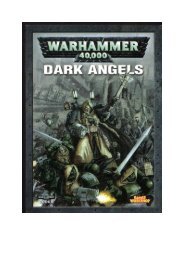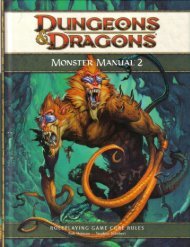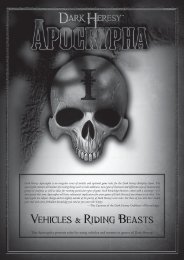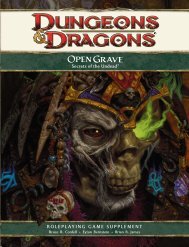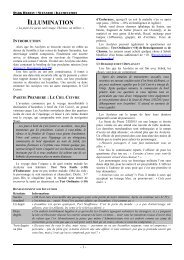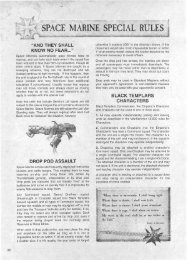You also want an ePaper? Increase the reach of your titles
YUMPU automatically turns print PDFs into web optimized ePapers that Google loves.
BLUE DRAGONS BY SIZEOverall Body Neck Tail Body Standing Maximum MinimumSize Length Length Length Length Width Height Wingspan Wingspan WeightMedium 16 ft. 7 ft. 4 ft. 5 ft. 3 ft. 4 ft. 24 ft. 12 ft. 320 lb.Large 31 ft. 13 ft. 7 ft. 11 ft. 5 ft. 7 ft. 36 ft. 18 ft. 2,500 lb.Huge 55 ft. 20 ft. 14 ft. 21 ft. 8 ft. 12 ft. 60 ft. 30 ft. 20,000 lb.Gargantuan 85 ft. 28 ft. 22 ft. 35 ft. 10 ft. 16 ft. 80 ft. 40 ft. 160,000 lb.Favored TreasureBlue <strong>dragons</strong> favor treasures as visually appealingas they are valuable. Blues love gems, particularlysapphires and other blue stones. They equallyadmire lovely works of art and jewelry. Althoughsuch an event is rare, given blues’ innate draconicgreed, blue <strong>dragons</strong> have been known to leavebehind treasures they find unattractive, feeling thatthe presence of such treasures would sully the magnificenceof their hoards and thus the magnificenceof the <strong>dragons</strong> themselves.Life CycleBlue dragon eggs incubate for approximately twentymonths, the last fifteen in the nest. An averageclutch numbers two to four, and most eggs hatch intohealthy wyrmlings.Blue <strong>dragons</strong> grow from wyrmlings into youthafter about seven years. They become adults aroundage 160 and elders after about a thousand years. Theybecome ancient at about 1,800. The oldest knownblue dragon died at approximately 2,300 years of age.A blue dragon that undergoes environmentaldiffusion after death creates a permanent storm inthe vicinity. This effect happens even underground,though cramped conditions might slacken thestrength of the winds. Although the severity of windand rain rises and falls, ranging from gentle gusts andmild showers to hurricane-force torrents, the stormnever dissipates entirely, regardless of the prevailingweather conditions outside it.OPTIONAL RULESA blue dragon ignores any cover or concealment grantedby rain and other nonfrozen precipitation.Because its scales so closely match the surroundingsky, a flying blue dragon can make Stealth checks to hidefrom creatures on the ground or at lower altitude, evenif it does not have cover or concealment. (It still takesall standard Stealth penalties for movement and otheractions it might take.)Due to its powerful claws and its habit of burrowing inthe sand or soil of its territory, a blue dragon has a burrowspeed equal to half its land speed.When flying and fighting in a storm or inclementweather, a blue dragon ignores any movement (includingforced movement) or cover penalties associated with thestorm.Physical CharacteristicsThe scales of blue <strong>dragons</strong> are slightly more reflectivethan those of other <strong>chromatic</strong> <strong>dragons</strong>. A personcould not use a blue dragon’s scales as mirrors, butin blue or dark environments, the scales take on thesurrounding hue and blend into the sky or elementsaround them.The horns and brow ridge of a blue dragon funnelrainwater and other precipitation away from theeyes. When combined with a blue dragon’s keenvision, this feature enables the dragon to see better ininclement weather than most creatures do.The wings of blue <strong>dragons</strong> are more flexible thanthose of other <strong>chromatic</strong>s. Blue <strong>dragons</strong> use winds tosteer and to boost their speed, like sailors tacking aship.A blue dragon might smell of ozone, though thepresence of a storm or even a mild wind can maskthis scent.Brown DragonsBrown <strong>dragons</strong> revel in the comfort of sand-coveredlairs filled with treasure they have filched fromdesert tombs. Browns also like exotic live food kidnappedfrom far lands.To come face to face with a brown dragon requiresextra work on the part of a would-be vanquisher.Brown <strong>dragons</strong> accomplish their goals in a mannerthat puts them in the least amount of danger—or, more accurately, requires the least effort. Forinstance, if given a choice between attacking anarmed castle to eat the baron’s horses or swoopingdown on a straggling bull among a herd of buffalo, abrown dragon chooses the latter.Nevertheless, a diet of buffalo or other easilyacquired herd animals pales after a time, so evenrisk-averse, relatively easygoing brown <strong>dragons</strong> mighttake progressively greater risks to try new flavors.Brown <strong>dragons</strong>, enamored with eating well, sometimesdesign elaborate schemes for obtaining unusualmorsels—schemes of a sort that other <strong>dragons</strong> wouldapply toward stealing great treasure or defendingtheir lairs. To brown <strong>dragons</strong>, life is best lived byeating often and well. A black dragon might find satisfactionin a diet of swamp things and the occasionaldrowned adventurer, but a brown dragon’s ultimatehappiness comes with new tastes and spices.In the extreme, this peculiarity can result in abrown dragon taking unnecessary risks in the heat ofCHROMATIC DRAGONS IN DETAILCHAPTER 1 | Dragon Lore33



